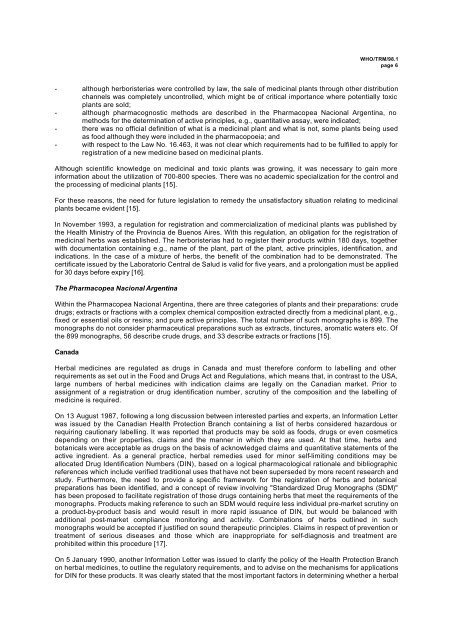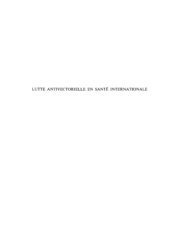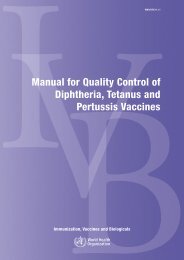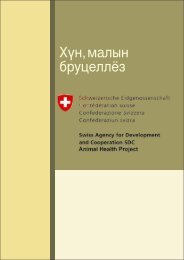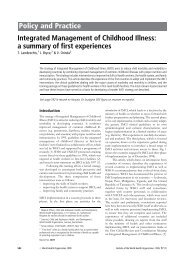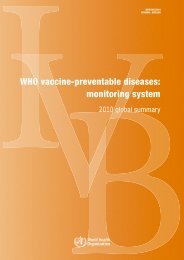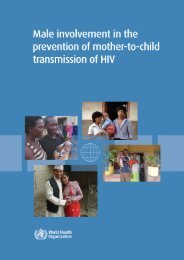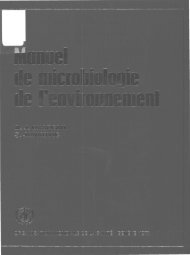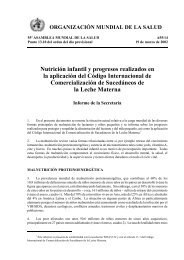Regulatory Situation of Herbal Medicines A worldwide Review
Regulatory Situation of Herbal Medicines A worldwide Review
Regulatory Situation of Herbal Medicines A worldwide Review
You also want an ePaper? Increase the reach of your titles
YUMPU automatically turns print PDFs into web optimized ePapers that Google loves.
WHO/TRM/98.1page 6- although herboristerias were controlled by law, the sale <strong>of</strong> medicinal plants through other distributionchannels was completely uncontrolled, which might be <strong>of</strong> critical importance where potentially toxicplants are sold;- although pharmacognostic methods are described in the Pharmacopea Nacional Argentina, nomethods for the determination <strong>of</strong> active principles, e.g., quantitative assay, were indicated;- there was no <strong>of</strong>ficial definition <strong>of</strong> what is a medicinal plant and what is not, some plants being usedas food although they were included in the pharmacopoeia; and- with respect to the Law No. 16.463, it was not clear which requirements had to be fulfilled to apply forregistration <strong>of</strong> a new medicine based on medicinal plants.Although scientific knowledge on medicinal and toxic plants was growing, it was necessary to gain moreinformation about the utilization <strong>of</strong> 700-800 species. There was no academic specialization for the control andthe processing <strong>of</strong> medicinal plants [15].For these reasons, the need for future legislation to remedy the unsatisfactory situation relating to medicinalplants became evident [15].In November 1993, a regulation for registration and commercialization <strong>of</strong> medicinal plants was published bythe Health Ministry <strong>of</strong> the Provincia de Buenos Aires. With this regulation, an obligation for the registration <strong>of</strong>medicinal herbs was established. The herboristerias had to register their products within 180 days, togetherwith documentation containing e.g., name <strong>of</strong> the plant, part <strong>of</strong> the plant, active principles, identification, andindications. In the case <strong>of</strong> a mixture <strong>of</strong> herbs, the benefit <strong>of</strong> the combination had to be demonstrated. Thecertificate issued by the Laboratorio Central de Salud is valid for five years, and a prolongation must be appliedfor 30 days before expiry [16].The Pharmacopea Nacional ArgentinaWithin the Pharmacopea Nacional Argentina, there are three categories <strong>of</strong> plants and their preparations: crudedrugs; extracts or fractions with a complex chemical composition extracted directly from a medicinal plant, e.g.,fixed or essential oils or resins; and pure active principles. The total number <strong>of</strong> such monographs is 899. Themonographs do not consider pharmaceutical preparations such as extracts, tinctures, aromatic waters etc. Ofthe 899 monographs, 56 describe crude drugs, and 33 describe extracts or fractions [15].Canada<strong>Herbal</strong> medicines are regulated as drugs in Canada and must therefore conform to labelling and otherrequirements as set out in the Food and Drugs Act and Regulations, which means that, in contrast to the USA,large numbers <strong>of</strong> herbal medicines with indication claims are legally on the Canadian market. Prior toassignment <strong>of</strong> a registration or drug identification number, scrutiny <strong>of</strong> the composition and the labelling <strong>of</strong>medicine is required.On 13 August 1987, following a long discussion between interested parties and experts, an Information Letterwas issued by the Canadian Health Protection Branch containing a list <strong>of</strong> herbs considered hazardous orrequiring cautionary labelling. It was reported that products may be sold as foods, drugs or even cosmeticsdepending on their properties, claims and the manner in which they are used. At that time, herbs andbotanicals were acceptable as drugs on the basis <strong>of</strong> acknowledged claims and quantitative statements <strong>of</strong> theactive ingredient. As a general practice, herbal remedies used for minor self-limiting conditions may beallocated Drug Identification Numbers (DIN), based on a logical pharmacological rationale and bibliographicreferences which include verified traditional uses that have not been superseded by more recent research andstudy. Furthermore, the need to provide a specific framework for the registration <strong>of</strong> herbs and botanicalpreparations has been identified, and a concept <strong>of</strong> review involving "Standardized Drug Monographs (SDM)"has been proposed to facilitate registration <strong>of</strong> those drugs containing herbs that meet the requirements <strong>of</strong> themonographs. Products making reference to such an SDM would require less individual pre-market scrutiny ona product-by-product basis and would result in more rapid issuance <strong>of</strong> DIN, but would be balanced withadditional post-market compliance monitoring and activity. Combinations <strong>of</strong> herbs outlined in suchmonographs would be accepted if justified on sound therapeutic principles. Claims in respect <strong>of</strong> prevention ortreatment <strong>of</strong> serious diseases and those which are inappropriate for self-diagnosis and treatment areprohibited within this procedure [17].On 5 January 1990, another Information Letter was issued to clarify the policy <strong>of</strong> the Health Protection Branchon herbal medicines, to outline the regulatory requirements, and to advise on the mechanisms for applicationsfor DIN for these products. It was clearly stated that the most important factors in determining whether a herbal


